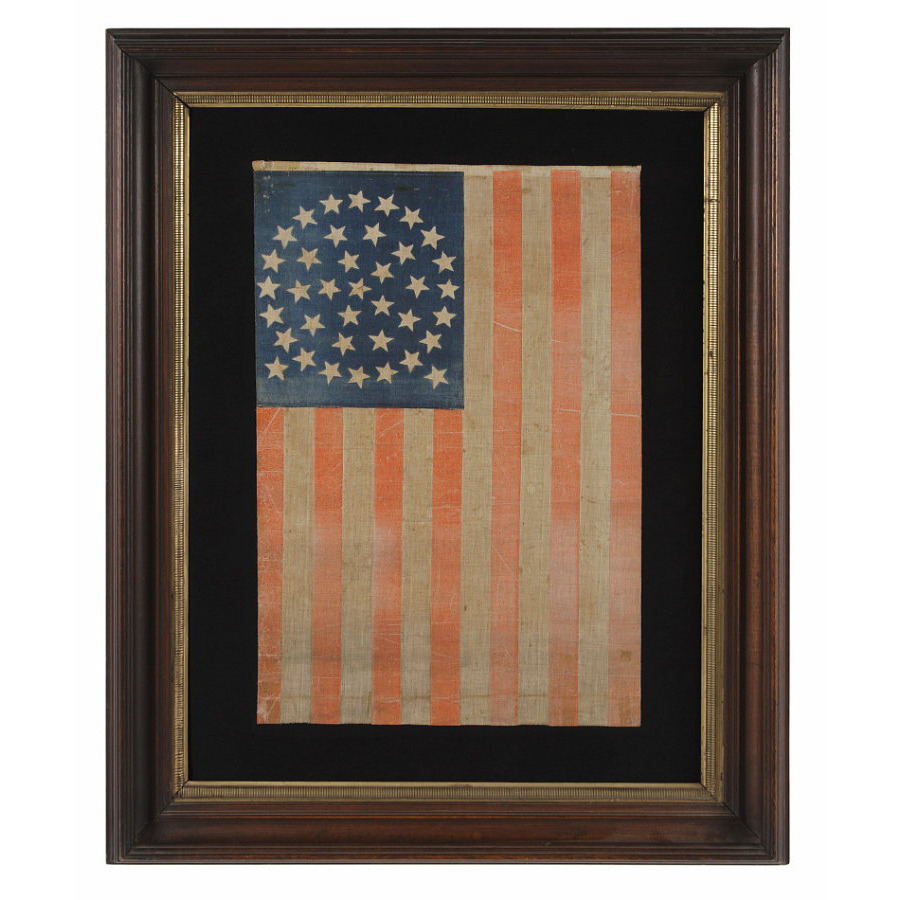
| |
ANTIQUE AMERICAN PARADE FLAG WITH 38 STARS IN A MEDALLION CONFIGURATION WITH 2 OUTLIERS, COLORADO STATEHOOD, 1876-1889, A LARGE, BOLD EXAMPLE |
|
| Available: |
Sold |
| Frame Size (H x L): |
38.5" x 30.5" |
| Flag Size (H x L): |
26.25" x 17.25" |
|
| Description....: |
|
ANTIQUE AMERICAN PARADE FLAG WITH 38 STARS IN A MEDALLION CONFIGURATION WITH 2 OUTLIERS, COLORADO STATEHOOD, 1876-1889, A LARGE, BOLD EXAMPLE:
38 star American parade flag, block-printed by hand on coarse, glazed cotton. The stars are arranged in a triple-wreath form of the medallion configuration, with a single center star and two stars flanking outside the basic pattern toward the fly end. Typically there are 4 flanking stars outside this type of pattern, one in each corner. The inclusion of only two was done intentionally to leave room for the easy addition of two more states. Flag-makers felt that more Western Territories were soon to be added to the Union and eagerly anticipated their arrival.
Note how the indigo blue canton contrasts pleasantly with the orange stripes. These were printed with a pigment colored with madder, which has a red-orange hue. It is for this reason that many cotton parade flags produced between 1850 and 1876 have shades of red that lean strongly toward orange.
Colorado became the 38th state on August 1st, 1876. This was the year of our nation's centennial of independence from Great Britain. Although 37 was the official star count for the American flag in 1876, flag-making was a competitive venture, and no one wanted to be making 37 star flags when others were making 38's. It is for this reason that 38 and 13 stars (to represent the original 13 colonies) are the two star counts most often seen at the Centennial International Exposition, the six-month long, World's Fair event, held in honor of the anniversary, in Philadelphia. Some flag-makers were actually producing 39 star flags, in hopeful anticipation of the addition of another Western Territory. The 38 star flag became official on July 4th, 1877 and was generally used until the addition of the Dakotas in 1889.
Mounting: The substantial, solid walnut molding dates to the period between 1860 and 188, has a deep profile, and a gilded liner with striped decoration. The flag has been hand-sewn to a background of 100% cotton twill, black in color, which was washed to reduce excess dye. An acid-free agent was added to the wash to further set the dye and the fabric was heat-treated for the same purpose. The glazing is U.V. protective acrylic.
Condition: There is moderate fading of the red stripes and minor to moderate foxing and oxidation throughout. There is minor pigment loss and minor to moderate fading. There are minor holes along the hoist, where the flag was affixed to its original staff and there are minor tears with associated loss at the fly end, primarily located in the top, fly end corner. The flag presents beautifully. Many of my clients prefer early flags to show their age and evidence of use. |
|
|
|
| Collector Level: |
Intermediate-Level Collectors and Special Gifts |
|
| Flag Type: |
Parade flag |
|
| Star Count: |
38 |
|
| Earliest Date of Origin: |
1876 |
|
| Latest Date of Origin: |
1889 |
|
| State/Affiliation: |
Colorado |
|
| War Association: |
1866-1890 Indian Wars |
|
| Price: |
SOLD |
|
| |
Views: 3189 |
|
|
|

